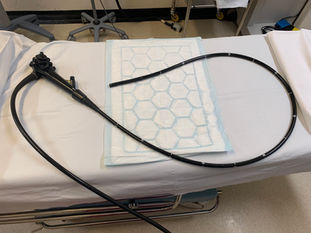What is a flexible sigmoidoscopy?
A flexible sigmoidoscopy is a procedure which allows for examination of the lining of the bowel (colon) through your back passage. It is similar to a colonoscopy however, during a flexible sigmoidoscopy only the lining of the left side of the bowel is examined (rectum, sigmoid colon, and descending colon). The procedure is performed by endoscopic specialists, a doctor or a nurse, who have been trained in how to perform the test. This procedure uses a long, narrow, flexible camera called an colonoscope (see picture)

What are the benefits?
The main benefit of a flexible sigmoidoscopy being performed is to find a cause of your symptoms. An added benefit is the ability to remove polyps during the procedure (if appropriate). Flexible Sigmoidoscopy is also used as part of cancer screening and treatment (BowelScope), it has been found to help to reduce the number of people dying from bowel cancer.
What are the risks?
For the majority of patients, a flexible sigmoidoscopy is a safe examination and thankfully serious complications are rare. However, you do need to weigh up the risks and benefits before having the procedure. It is important to note that the sedation can also have risks as well as the procedure itself.
The main risks are:
• Perforation in the lining of the bowel. This happens in <1:5000 patients. The risk can be higher if you have a polyp removed.
• Bleeding at the site of a biopsy or removal of a small polyp - this is usually only minor and resolves on its own, bleeding risks increase the larger the polyp removed.
• Due to the nature of the bowel with its folds and grooves, lesions can be missed.
• Incomplete procedure due a technical difficultly or poor bowel preparation.
What are the alternatives?
You are under no obligation to have this procedure. Any suitable alternatives should have been discussed in advance with your clinician.
There are alternatives to a flexible sigmoidoscopy is a CT scan.
CT Scan
A CT scan is a type of x-ray that usually gives very detailed images, it therefore exposes you to a degree of radiation.The scan may also require the use of bowel preparation. Unlike a sigmoidoscopy, is impossible to take biopsies or remove polyps from the bowel. A CT scan may be the appropriate option for some patients, for example those who are older, frailer and with multiple heath conditions, or unable to have a sigmoidoscopy.

The decision is yours as to whether to have a sigmoidoscopy or not. However, without a sigmoidoscopy your doctor may not be able to find a cause of your symptoms and it may be difficult to plan any further treatment.
